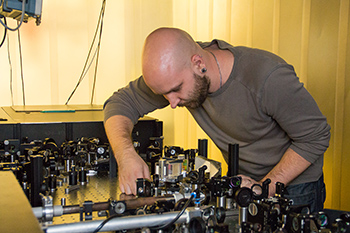
Postdoctoral fellow Skirmantas Ališauskas with the driver laser. Credit: Vienna University of Technology
Materials scientists use short X-ray pulses to study ultrafast structural molecular dynamics. Researchers based in Austria have created a new optically driven source of pulsed hard X-rays to provide this type of radiation on a lab bench (Nat. Photon., doi:10.1038/nphoton.2014.256).
Scientists carrying out these structural-dynamics experiments with tabletop X-ray sources measure absorption and diffraction with photon statistics, so a high flux of source radiation is needed. Andrius Baltuška's group at the Vienna University of Technology achieved a flux of roughly 109 photons per pulse by driving their pulse generator with a mid-infrared laser system based on optical parametric chirped pulse amplification.
The team set up their driver laser, with a wavelength of 3.9 μm, in a vacuum chamber and aimed it at a 20-μm-thick copper tape, which continuously moved past the laser to provide a fresh target for each of the pulses (repetition rate: 20 Hz). The light energy pushes inner electrons of the copper atoms to higher orbits, and when they drop back down, they release photons with the characteristic energy of the Kα spectral lines of copper (8.0 and 8.9 keV).
In previous work, the team had used the same setup with an 800-nm-wavelength Ti:sapphire laser as the optical driver. However, the mid-infrared pulses accelerate electrons much more efficiently than their shorter counterparts, giving the electrons higher kinetic energy and resulting in an X-ray photon flux 25 times higher than achieved with the near-infrared laser.
Based on theoretical calculations, the researchers predict that they could boost the X-ray flux by tweaking the experimental parameters—changing the angle of incidence of the driver beam on the copper tape and using a thinner copper tape, for example. They also suggest experimenting with heavier elements, such as molybdenum, in the target tape to release Kα photons at even higher energies.
Scientists from the Max Born Institute for Nonlinear Optics and Short Pulse Spectroscopy in Berlin, Germany, also participated in the research project.
